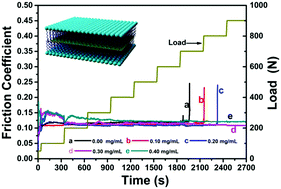Improved ordering and lubricating properties using graphene in lamellar liquid crystals of Triton X-100/CnmimNTf2/H2O†
Abstract
Graphene has been studied extensively owing to its excellent lubricity performance. However, when used as lubricant additives, graphene layers tend to agglomerate and precipitate; further, poor dispersion will reduce the lubrication performance. Herein, graphene was evenly dispersed in Triton X-100/1-alkyl-3-methylimidazole ditrifluorosulfonylimide (CnmimNTf2)/H2O (n = 8, 12, and 16) lamellar liquid crystals (LLCs). The effects of the graphene concentration on the microstructures of the LLCs are detected by 2H NMR and small angle X-ray scattering measurements and their rheological and tribological performance are investigated in detail. The addition of 0.30 mg mL−1 graphene into the Triton X-100/C16mimNTf2/H2O LLC system led to a 15% reduction in the friction coefficient and 65% reduction in the wear volume when compared with the pure LLCs. The synergistic effect of the graphene and LLC hybrid system efficiently improved the lubrication performance, which is attributed to the higher order of the amphiphilic molecules and the thicker amphiphilic bilayer. The generated tribofilm formed by the physical adsorption and the tribochemical reaction of LLCs on the surface of steel is conducive to lubricity protection from abrasion. This study reveals that with the understanding of the microstructure change mechanism, the combination of graphene and LLCs could provide a new path to the design of a novel lubricant that can be utilized in nanostructures for energy saving applications.



 Please wait while we load your content...
Please wait while we load your content...